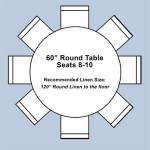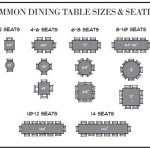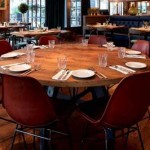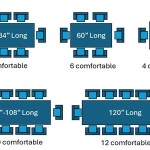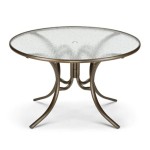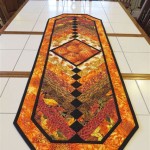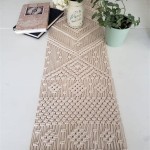How Big Is A Rectangular Table That Seats 8?
Determining the appropriate size for a rectangular table that seats eight people involves considering several factors, including comfort, functionality, and the overall dimensions of the dining space. A table that is too small will feel cramped and uncomfortable, while a table that is too large may overwhelm the room and hinder movement. Therefore, careful planning and consideration of these factors are essential to selecting the ideal table size for a dining area.
The primary consideration when selecting a dining table is the amount of space allocated per person. This space directly impacts comfort during meals and allows individuals to move freely without bumping elbows or feeling confined. Generally, a comfortable width allowance per person ranges from 24 to 30 inches. This spacing ensures adequate personal space for eating and socializing.
Beyond individual space, the depth of the table also contributes to overall comfort and functionality. The table's depth, or width, should accommodate serving dishes, centerpieces, and place settings without feeling overcrowded. A depth of at least 36 inches is generally recommended, but a greater depth, around 42 to 48 inches, can provide more room for larger gatherings or elaborate table settings.
When calculating the ideal dimensions for a rectangular table seating eight, one must remember that the end of the table also offers seating. Rectangular tables typically seat one person at each end. Therefore, the calculation focuses on providing sufficient space along the longer sides of the table.
Calculating the Length of the Table
To determine the optimal length, one multiplies the desired width allowance per person by the number of people seated on each side. Since a rectangular table seating eight will have three people seated on each side, the calculation involves multiplying the per-person width allowance by three. For example, if a width allowance of 24 inches per person is preferred, the calculation would be 24 inches/person * 3 people = 72 inches. This represents the minimum length needed for the two sides of the table to comfortably seat six individuals, excluding the two individuals at each end.
Adding space for the two people seated at each end of the table requires a further consideration. While the end-seated guests share the width of the table as their personal space, adding at least 12 inches per end is recommended to provide sufficient legroom and space for comfortable dining. Adding these 24 inches (12 inches x 2 ends) to the 72 inches calculated for the sides, the total minimum length for a rectangular table comfortably seating eight should be approximately 96 inches, or 8 feet. If aiming for a more generous spacing of 30 inches per person, the total length would increase: (30 inches/person * 3 people) + 24 inches = 114 inches, or 9.5 feet.
Therefore, depending on the desired level of personal space, the length of a rectangular table seating eight should ideally fall between 8 feet and 9.5 feet to ensure a comfortable dining experience. A table shorter than 8 feet may feel cramped, while a table exceeding 9.5 feet may become unwieldy and require a larger dining space.
Considerations for Table Width (Depth)
The width, or depth, of the table also significantly impacts the overall dining experience. A wider table provides more room for serving dishes, decorations, and individual place settings. It also allows for easier conversation across the table.
As previously mentioned, a minimum width of 36 inches is generally recommended. This allows for a central serving area and leaves sufficient room for individual place settings on either side. However, for larger families or those who frequently entertain, a width of 42 to 48 inches is often preferred. This added width provides a more spacious and comfortable dining environment.
When selecting a table width, it's essential to consider the reach across the table. A table that is too wide can make it difficult for individuals to reach serving dishes or engage in conversation with those seated on the opposite side. A good rule of thumb is to ensure that no one has to stretch excessively to reach the center of the table. For most individuals, a width of 48 inches is typically the maximum comfortable reach.
Therefore, for a rectangular table seating eight, a width of 36 to 48 inches represents a comfortable and functional range. The specific choice will depend on personal preferences, the frequency of entertaining, and the overall size of the dining space.
The Impact of Dining Room Size and Shape
The dimensions of the dining room itself play a vital role in determining the appropriate size of the table. A large dining room can easily accommodate a larger table, while a smaller dining room may require a more compact design.
When planning the layout of the dining room, it's essential to allow for adequate space around the table. A minimum of 36 inches of clearance between the edge of the table and the walls or other furniture is recommended to allow for comfortable movement around the table. This clearance ensures that individuals can easily pull out chairs and walk around the table without feeling cramped.
For smaller dining rooms, consider a table with leaves or extensions. These tables can be adjusted to accommodate more or fewer guests as needed. When not in use, the leaves can be removed to create a smaller table that fits more comfortably in the space.
The shape of the dining room also influences the optimal table shape. While rectangular tables are a popular choice, other shapes, such as oval or round, may be more suitable for certain room layouts. For example, a round table can work well in a square dining room, while a rectangular table may be a better fit for a long, narrow dining room.
In summary, to determine the ideal size of a rectangular table that seats eight, one must consider the desired level of personal space, the width needed for functionality, and the dimensions of the dining room. A careful balance of these factors will ensure a comfortable, functional, and aesthetically pleasing dining environment.
Beyond the core dimensional considerations, the material of the table influences not only aesthetics but also durability and maintenance. Solid wood tables, for example, offer long-lasting quality but typically require more care than tables constructed from laminate or metal. The choice of a tabletop finish, whether it is a natural wood stain, a painted surface, or a glass overlay, also impacts the cleaning process and resistance to scratches or spills. A well-chosen material and finish will complement the dining room's design and withstand the rigors of regular use.
The style of the table should also harmonize with the existing décor of the dining room. A modern dining room, characterized by clean lines and minimalist aesthetics, may be best suited to a rectangular table with a simple design and metal legs. Conversely, a traditional dining room, often featuring ornate details and warm colors, may benefit from a wooden table with carved legs and a rich, dark finish. The integration of the table's style into the overall room design creates a cohesive and visually appealing space.
In addition to the table itself, the chairs selected for the dining area play a crucial role in comfort and functionality. The height of the chairs should be appropriately matched to the height of the table, typically with about 12 inches of space between the seat and the underside of the table. The width and depth of the chairs should also be considered to ensure that they fit comfortably under the table when not in use. Armchairs can provide added comfort, but they may also require more space. The style of the chairs should complement the table's design and contribute to the overall aesthetic of the dining room.
Finally, lighting plays a significant role in creating a welcoming and functional dining environment. A chandelier or pendant light positioned directly above the table can provide ample illumination for meals and create a focal point in the room. Additional lighting, such as wall sconces or recessed lights, can be used to supplement the central light source and create a more layered and inviting atmosphere. The lighting should be carefully chosen to enhance the dining experience and complement the overall décor of the room.
Therefore, selecting a rectangular table that comfortably seats eight requires careful consideration of numerous factors, including dimensions, materials, style, chairs, and lighting. By taking these elements into account, one can create a dining space that is both functional and aesthetically pleasing, providing a welcoming environment for meals and gatherings.

8 Ft Rectangular Banquet Table For Orange County Ca On Call Event Als

Creative 8 Person Dining Table Size For Your Enjoyment Sizes Outdoor Diy

Table Seating Guide The Treasure Place

Conference Tables Size Seating Clear Choiceos

8 Ft Rectangular Table Seats People Confortably

Rectangle Table Seating Chart The Chiavari Chair Company

Table Als Big Tent Events

Right Fit For Dinner A Table And Chair Sizing Guide Timber To

How To Calculate Rectangular Table Seating Capacity Diy Dining Sizes Room

Choosing The Best Table Style Kaplan Early Learning Company
Related Posts

